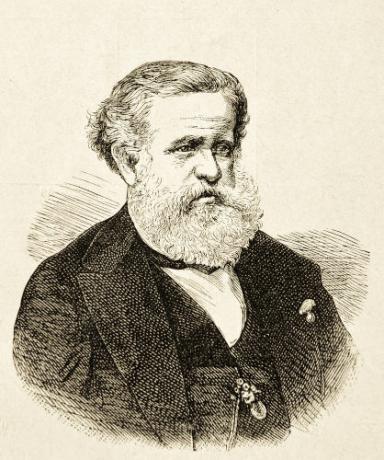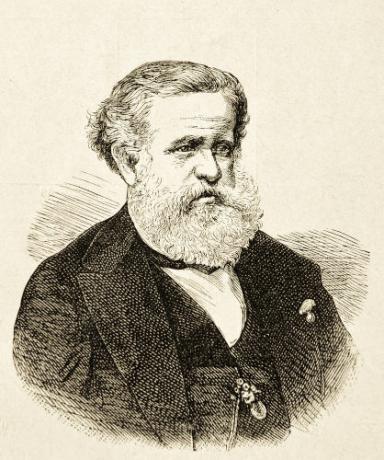D. Pedro II he was recorded in history as the longest-serving governor of Brazil. He was emperor during the Second Reign and occupied the throne in 1840 through the Coup of Majority, being dethroned in 1889 due to proclamation of the Republic. He died in Paris, where he went into exile after being expelled from Brazil.
read more: War of Cisplatin - conflict in which Brazil participated during the reign of Pedro I
birth and youth
Pedro de Alcântara João Carlos Leopoldo Salvador Bibiano Francisco Xavier de Paula Leocádio Miguel Gabriel Rafael Gonzaga, known in Brazilian history as d. Pedro II was born on December 2, 1825, in Paço do São Cristóvão, in the city of Rio de Janeiro, the capital of Brazil at the time.
Pedro de Alcântara was the son of the first emperor of Brazil, d. Peter I, and of his first wife, the Austrian d. Maria Leopoldine. He was the youngest child of this couple, but became an heir because his older brothers, Miguel and João Carlos, did not survive childhood. He also had four sisters, but the monarchy's succession law gave primacy to children.
Pedro grew up without his parents' company, as his mother died when he was just one year old and his father abandoned him to return to Portugal after he abdicated the throne in 1831. Pedro de Alcântara's childhood was then surrounded by his tutors, who took care of training him so that he could assume the throne when he was of age.
During childhood, Pedro de Alcântara had Maria Catarina Equey as a wet nurse and d. Mariana Carlota de Verna as your maid. The second was mainly responsible for the education of the future emperor of Brazil. D. Mariana Carlota remained close to Pedro de Alcântara throughout her life, and he affectionately called her “Dadama”.
Coup of Age

The education of d. Pedro always aimed at the day when he assumed the throne of Brazil. THE Brazilian law determined that he would assume the throne when he turned 18, that is, when he came of age. Until that happened, the country would be governed by regents, a period known as regency.
It turns out that the regency period was quite politically troubled and a series of rebellions popped up in Brazilian territory. O risk of territorial fragmentation caused the politicians to unite by anticipating the coming of age of d. Peter. It would only happen in 1843, but this possibility had been discussed since 1835.
In 1840, liberal politicians, dissatisfied with the regency in the hands of conservatives, proposed to the Senate to anticipation of adulthood of the emperor. The proposal was also well regarded by conservatives, as the monarch was considered the only one capable of guaranteeing the country's centralized power and territorial unification.
On July 23, 1840, Pedro de Alcântara was considered of legal age. The coronation ceremony was held in Rio de Janeiro on July 18, 1841, and caused him to be acclaimed and crowned d. Pedro II, Emperor of Brazil. This event was called the Coup of Majority because it anticipated the coming of age of d. Peter stops 14 years. If you want to go deeper into the topic of this topic, read: Coup of Age.
Wedding
Right after taking over, d. Pedro II went through the consolidation process of his reign, in which he had to understand the functioning of politics and accommodate the interests. One of the steps in this process was to find a wife for the emperor. As he approached the age of 18, the issue of marriage became a state urgency.
At searches for a wife were not easy by the fact that Brazil is a minor monarchy, seen as exotic by Europeans, and by the bad reputation of d. Pedro I with regard to the issue of fidelity. Anyway, she came up with the name of Teresa Maria Cristina, princess of the Two Sicilies. D. Pedro II received a portrait sent by the Court of the princess, he liked what he saw, and the wedding went ahead.
For her, it was an important opportunity because she belonged to an impoverished royal family that offered a small dowry. The chance to marry an emperor and a rich monarchy was unmissable. To him she was a opportunity to link up with a European monarchy who had Bourbon and Habsburg descent.
The marriage took place by proxy in Naples, on May 30, 1843, and on September 3 of the same year, she arrived in Brazil. D. Pedro II welcomed his wife as soon as the vessel that brought her arrived in Rio de Janeiro, but reports from the time tell of his disappointmentupon meeting her.
The portrait of Maria Teresa was not loyal to reality, and, arriving in Rio de Janeiro, d. Pedro II could see that she was obese, short and a little lame. Some historians point out that the emperor's disappointment was evident, and historians Lilia Schwarcz and Heloisa Starling claim that he would have been weeping with disappointment along with his maid and his butler.|1|. Anyway, from this marriage the following children were born: Alphonsus, Isabel, Leopoldine and PeterAlphonsus.
Accessalso: Monarchy - oldest form of government still in force in the world
second reign
The reign of d. Pedro II was the longest government of a person in the history of Brazil, since the monarch occupied the throne from 1840 to 1889. During this period, d. Pedro II faced great challenges, and one of the most important issues took place in his first decade as emperor: the prohibition of the slave trade.
During the reign of d. Pedro II, O coffee consolidated itself as the main product of the economy Brazilian, developing in the Southeast region of the country. From the point of view of foreign policy, the reign of d. Pedro II had to deal with Brazil's complicated relations with the La Plata Basin nations.
Brazilian relations with Argentina, Uruguay and Paraguay were complex and, on several occasions, this generated friction and conflicts between Brazil and neighboring nations. One of the places of greatest tension in diplomatic issues was Uruguay, and because of that country, Brazil became involved in a war against the Argentina and another against Paraguay, and also intervened militarily in the country to ensure Uruguay's alignment with Uruguayan interests. Brazilians.
One of those conflicts was the Paraguay War, the biggest clash in the history of South America, fought between 1864 and 1870. This war was caused by the divergence of interests between Paraguay and Brazil in Uruguayan politics, border issues and navigation of the rivers in the La Plata Basin. The result was a war that destroyed Paraguay and indebted Brazil.
The Paraguay War also allowed the strengthening of the Brazilian Army. The professionalization of the military made them place themselves as one of the groups most dissatisfied with the monarchy in Brazil. The military was one of the groups that most mobilized for the overthrow of the monarchy here.
Finally, another important issue from the reign of d. Pedro II went to abolition of slavery. Historians claim that, personally, d. Pedro II was in favor of the abolitionist cause, but still, he reigned for nearly half a century until slavery was abolished, and throughout that period, was lenient with the existence of this institution. To learn more about this period of the Brazilian monarchy, read: second reign.
Last years

The last years of the life of d. Pedro II were marked by health problems and the emperor's unwillingness to govern. From the 1870s and 1880s, for example, d. Pedro II made several trips that earned him criticism in Brazil. As the press was free during his reign, criticism was frequently aired.
In the late 1880s, his daughter, Princess Isabel, came to be conductor from Brazil at times. The possibility of succession also did not encourage the subjects much, since Princess Isabel was seen with suspicion and her husband, the French Count D’ Eu, was also not one of the most appreciated.
THE conspiracy against the monarchy gained strength, starting on November 15, 1889. At that moment, d. Pedro II and his wife were in Petropolis, and the emperor was not at all nervous about the events. He thought he would work things out as soon as he got to Rio de Janeiro, but he soon received the summons to leave Brazil.
On November 17, 1889, d. Pedro II, saddened, shipped to Europe. A few weeks after arriving on the mainland, his wife Teresa Cristina passed away. D. Pedro II spent the last years of his life living in Paris. In the French capital, he died on December 5, 1891, victim of a pneumonia.
Note
|1| SCHWARCZ, Lilia Moritz and STARLING, Heloísa Murgel. Brazil: a biography. São Paulo: Companhia das Letras, 2015. P. 272-273.
Image credits
[1] commons

